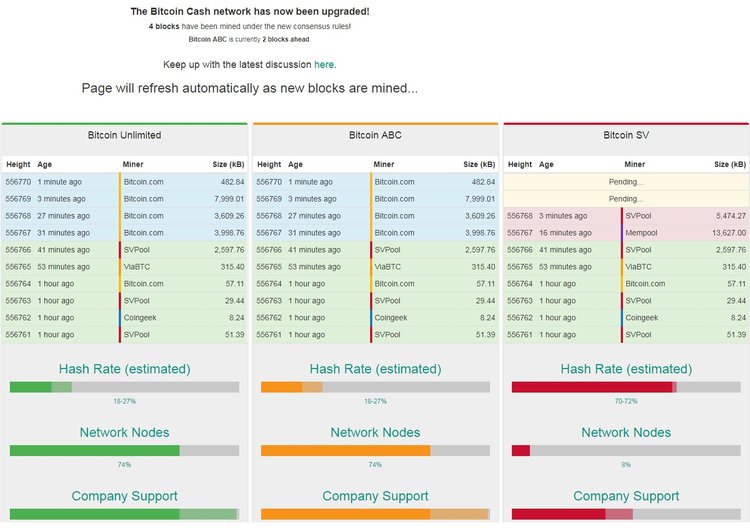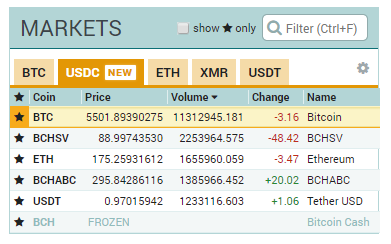Bitcoin Cash activated a hard fork. Now we can officially talk about BCH splitting into two competing blockchains.
The first block in the bitcoin ABC blockchain has been added by Bitcoin.com pool. The last common block was mined by SVPool block under #556,766, the one which activated the protocol update.
Bitfinex has already announced the transfer of BAB and BSV coins to the accounts of BCH holders.
BAB and BSV have been successfully credited to Bitfinex users and BCH positions have been claimed. The BCH symbol will not be assigned until the fork is complete.
— Bitfinex (@bitfinex) November 15, 2018
The next update of the network has been originally planned to take place on November 15, but the developers did not agree on the upcoming hard forks. The struggle unveiled between the partners of Bitcoin Cash – Jihan Wu, Roger Ver, and Craig Wright. The controversy led to a split in the Bitcoin Cash community, which resulted in the development of two different versions of the network update.
Two sides
The first version of the network update from the Bitcoin ABC team implies that a new opcode OP_CHECKDATASIG is to emerge, allowing users to exchange funds between different platforms. To address the issue of network scalability, developers intend to introduce a function of the Сanonical Transactions Ordering (CTOR) which changes the way transactions are listed in a block. The block size of 32 MB will be saved as a result.
The second team, the nChain company supported by the CoinGeek mining pool, intends to increase the size of the existing block to 128 MB, while returning to the original blockchain Bitcoin Cash. In addition, the developers propose using a digital coin only as a means of payment. This group is led by the nChain researcher Craig Wright. He is known for trying to impersonate the creator of bitcoin Satoshi Nakamoto, which led to the creator of ethereum Vitalik Buterin publicly calling him a liar. Wright openly quarreled with partners, believing that they were not on the right path and created the fork Bitcoin SV (Satoshi Vision).
51% attack
Craig Wright took advantage of the financial difficulties that Cihan Wu’s, his Bitcoin Cash partner, was facing at his company, when Bitmain publicly promised to drown Bitcoin Cash and even bought mining facilities that allow for a “51% attack”. When controlling such a share of computing power, their owner can dispose of transactions in the blockchain network at his discretion.
However, after the collapse of the crypto market, Bitmain itself was in trouble. According to TechCrunch, the company ended the second quarter of 2018 with a loss of approximately $400 million. Problems with financial performance reduced Bitmain’s chances of a successful IPO. Wu is a co-owner of the company. It was probably at this vulnerable moment that Craig Wright decided to target another asset of his former partner.
However, at the time of this writing, the bitcoin SV marginalization from Bitcoin ABC has slightly decreased in terms of the number of extracted blocks. Also, it seems that the “51% attack” has been canceled.
What's next?
After the hard fork, both chains may be dominant, but, most likely, one of them will have greater support and volume of trade than the other, though at the cost of reducing its value. So far, the BCHABC asset is traded on the Poloniex exchange at a much more expensive rate than BCHSV. However, in the future, the situation may change.
Whatever happened, the hard fork has taken place and the crypto community exhaled with relief. “Does it mean I can get out of my bunker now?” Reddit user writes. The CEO of Binance, Changpeng Zhao supports them.
Let's get this stupid fork over with already. I honestly don't like forks.
— CZ Binance (@cz_binance) November 15, 2018
Well, it really is high time to get out of the bunker, the first round of the ‘hash war’ is over, and we can follow the developments. After all, as Craig Wright notes, the game has just begun.
Game on.... pic.twitter.com/ix90s0G9tq
— Dr Craig S Wright (@ProfFaustus) November 15, 2018
Subscribe to our Telegram channel to stay up to date on the latest crypto and blockchain news.




